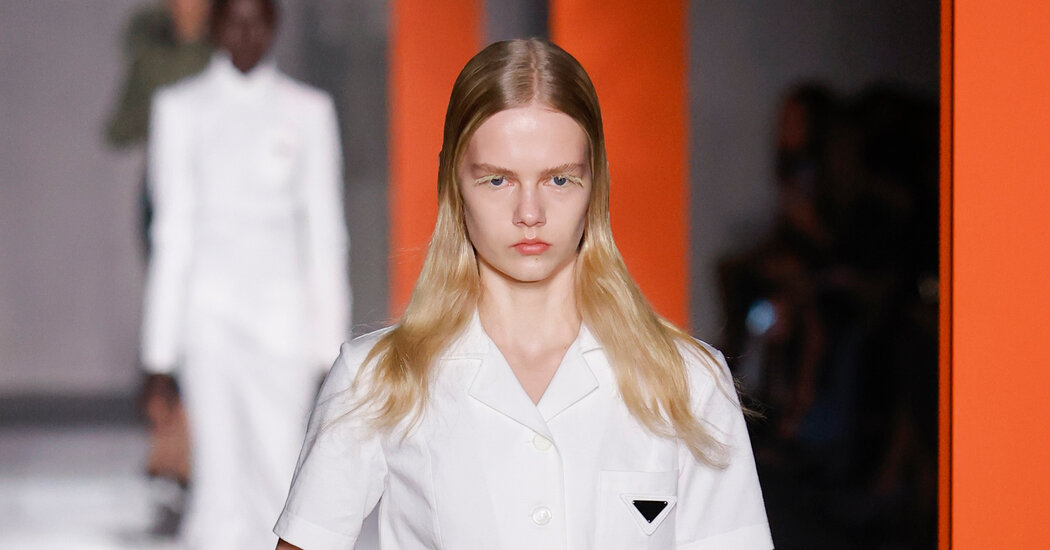
MILAN — The Prada show invitation did not arrive alone. It came with a delicate calla lily, rolled out of starched white cotton and ready to be pinned to a lapel. Also a door stopper of a 550-page monograph titled “Recycling Beauty” and chronicling the current exhibition at the Fondazione Prada: an examination of the way in which themes and materials (and ideas) are reused and reinvented over time.
How we see things and what we see in them changes according to context; how the familiar can be filched and made new, depending on the situation and the eye of the beholder. Sometimes that’s called a readymade, sometimes cheating, sometimes brilliance. Sometimes it’s a little fabric flower on a safety pin, like a peace offering.
Well, that’s the story of fashion. You take a garment with a hole for the head and two holes for the arms and maybe a little something for the legs and transform it according to custom and the exigencies of the moment.
And that’s what Miuccia Prada and Raf Simons did, in a Prada show that took the subject of uniforms — the kind that surround us, the kind that are so familiar they often go unseen (not the kind associated with the war in Ukraine, though it has been a year since Russia invaded, and the consequences have affected our closets in ways we don’t always realize) — and lavished them with the sort of detailed attention normally bestowed on couture.
The endless style appeal of uniforms is nothing new: It’s rooted deep in our psyche, capable of pushing emotional buttons both good and bad, depending on the memories and associations. But this gave a different twist to an old story.
It was different, for example, than the “personal uniform” often touted by fashion as desirable: the identifiable look adopted by an individual as a form of value or community signaling. And it was different from the default uniform developed by Silicon Valley figures like Mark Zuckerberg and Elizabeth Holmes, who espoused the value of wearing the same thing every day as a shortcut to freeing the mind. It was different from the performative deconstruction of Vivienne Westwood and Malcolm McLaren, which was a political statement of rebellion against the uniform; rejecting the idea of a dress code.
It was even different from what Kim Jones did at Fendi, though he was also playing with uniforms, albeit of the more white collar and Catholic school kind; taking pinstripes, kilts and suiting, layering them together and twisting them up just a little bit, then adding a touch of kink for interest. Imagine a skirt slit to the thigh at the side, for example, to show the shirttails and over-the-knee boots beneath; a long ribbed knit sliced open unexpectedly at the ribs.
This was reworking the uniform as a form of homage and devotion. It was acknowledging the comfort in the familiar and then amplifying that with a touch of grace. The point being, Mrs. Prada said during a joint interview backstage afterward, “to give importance to what is modest: a simple job, a modest job and not only extreme beauty.” To acknowledge, “beauty is in everyday things.”
That’s a laudable idea, though it’s also true that using certain uniforms as inspiration for clothes that people in such jobs will never be able to afford can smack of Marie Antoinette role play and noblesse oblige. But Prada has a long history with finding beauty in the quotidian. And the point isn’t about play acting, but rather recasting the whole story. You force people to look differently at the source material. Or to actually look at the source material to begin with.
Like duffle coats and parkas. Here in wool, with the back belled out like a cocoon and caught by a seam just at the top of the thighs, hands tucked into neat little pockets high on the ribs, so it changes the posture. Or caretakers’ shirt dresses, rendered as evening wear in crisp white cotton dropped narrowly to the ankles, hitched up on the bias at the hips and fishtailing behind on the floor (trains are a thing this season, also showing up at Fendi).
Or khaki shirts, with epaulets and even neckties, tucked into very high-waist peg-leg pants — the no-nonsense kind that could signal a move away from the low-slung wide-leg trousers that have been the dominant pants of the past year.
Even wedding gowns, the uniforms of romance, were turned into circle skirts and minis, bristling with white flowers or padded like duvets, and worn with plain gray sweaters or oversize dad jackets. There was very little decoration, save the flowers.
The colors were mostly gray, brown, army green and navy. It was all about the form: the curves carved by the clothed body in space. The function. And the emotional connections triggered.
And it is part of a definite swing this season away from escapism and toward an alternate theory of the role of fashion. Not as rebel yell of hedonism and fringe in the face of complicated realities, though that has its uses, but as a coping mechanism that does not demand too much.
It’s not the swaddling self-care clothing that was dominant during lockdown. It’s stuff made for being out in the world; stuff meant for navigating the world. And there are alternate propositions: At Moschino, Jeremy Scott often offers a bit of absurdist elegance, though this season his take on distorted reality via melting florals, dripping hemlines and rhinestones gone wild seemed more of a zigzag and less of a zinger.
But more and more it’s becoming clear that sometimes, especially when the job is hard, it’s OK for the clothes to be easy.






